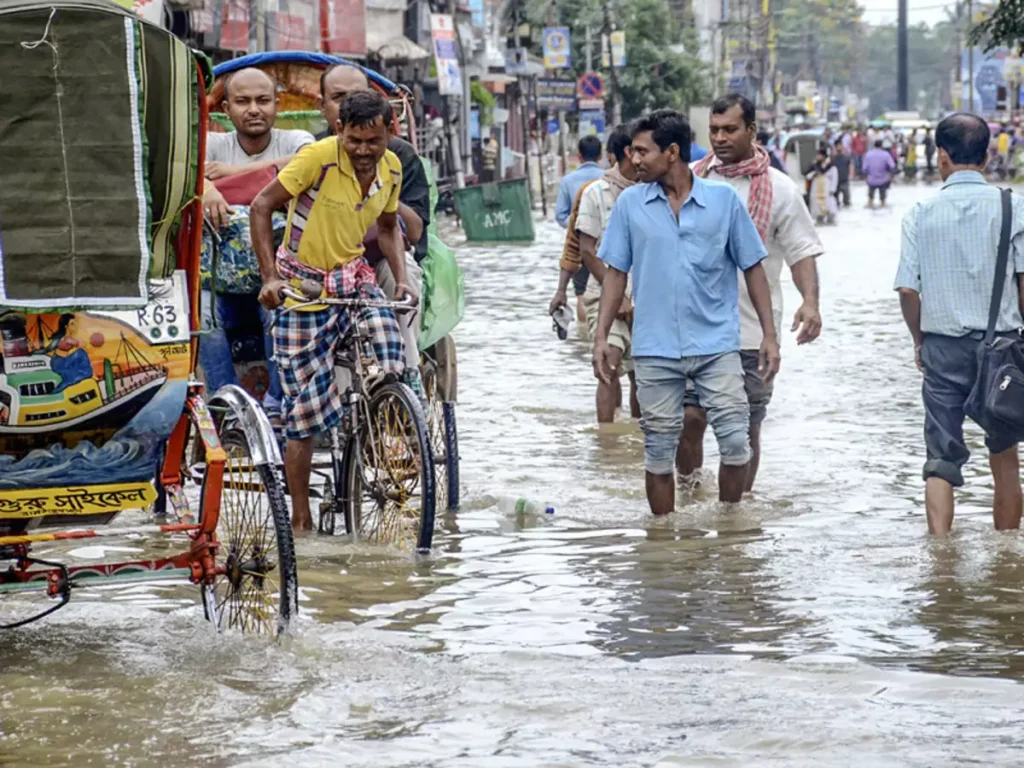Nestled in the lush, verdant landscapes of India’s northeastern states, where rivers wind through emerald valleys and dense forests whisper ancient tales, life has always been an intricate dance with nature. For generations, the people of this region have thrived on the land’s natural bounty, their lives closely intertwined with the rhythms of the environment. However, as climate patterns shift dramatically, this delicate balance is increasingly under threat. The communities that have long depended on the stability of their natural surroundings now face unprecedented challenges. Governing these regions has become a complex task, balancing development with the urgent need to preserve their fragile ecosystems. The recent events in Tripura have starkly exposed the harsh realities of climate change and how policies intended for development have, at times, exacerbated the fragility of these ecosystems.
The night the waters rose
On the night of August 19, the state of Tripura was gripped by a storm of terrifying magnitude. Torrential rains lashed the small state until the August 23, transforming tranquil rivers into roaring torrents and drowning entire communities in a matter of hours. As dawn broke and the waters began to recede, the scale of the devastation became horrifyingly clear. The Chief Minister, Dr Manik Saha, faced the cameras with a sombre expression, revealing that the floods had caused catastrophic losses amounting to ₹15,000 crores. Seventeen lakh people had been affected, with 1.7 lakh left homeless overnight. In a desperate bid to provide shelter, the state’s disaster management authorities hastily established 557 relief camps, housing over 1.28 lakh people across the worst-hit districts—Gomati, West Tripura, Khowai Tripura, and South Tripura.
The scale of the disaster was unlike anything the state had ever witnessed. In some areas, the rainfall was so intense that in just one day, 228.8 mm of rain fell, overwhelming every system in place to manage such a deluge. Environmentalists quickly pointed to the event as a textbook example of climate change’s devastating impact on this frontier state. Yet, the destruction extended far beyond human casualties. The toll on wildlife, aquatic ecosystems, and the region’s lush greenery remains unquantified, a grim reminder of the broader environmental crisis that now looms over the Northeast. The event underscored a harsh truth—this region’s increasing vulnerability to such catastrophic events is a clear and present danger.
Progress v preservation: What’s at stake for Assam’s Gibbon wildlife sanctuary?
As the people of Tripura struggled to pick up the pieces of their shattered lives, disquieting news from Assam added to the growing sense of unease in the region. Deep within the heart of the Gibbon Wildlife Sanctuary in Jorhat district, a new and potentially disastrous chapter was unfolding—one that could further endanger the fragile ecosystems that have long defined the Northeast’s natural beauty. Cairn Oil and Gas, a subsidiary of Vedanta Resources, had quietly set its sights on exploring oil and gas reserves buried beneath the sanctuary’s ancient trees, a prospect that many feared could irreparably harm the region’s biodiversity.
Since 2019, Cairn Oil and Gas had been laying the groundwork for this project, engaging with local communities and securing the necessary approvals to move forward. But it wasn’t until recently that the Chief Wildlife Warden of Assam, Sandeep Kumar, gave the final nod, recommending that the Forest Advisory Committee grant permission for the exploration to proceed. The decision was met with a mix of resignation and outrage. For some, it represented a step toward much-needed economic development. But for others, it was a troubling signal that the government was willing to sacrifice environmental and ecological interests on the altar of ‘projects of national interest.’
The Gibbon Wildlife Sanctuary is home to a population of endangered hoolock gibbons and wild elephants, species that rely on the sanctuary’s unspoiled forests for their survival. Now, with 4.49 hectares of land set aside for oil exploration, the sanctuary’s future hangs in the balance. The project is expected to receive final clearance from the Ministry of Environment and Forests within the week, marking yet another instance where the region’s natural heritage is bartered away in the name of industrial progress.
Hydropower dreams, downstream nightmares
One the one hand there is the growing need for generating power to light up homes and hearths of people while on the other there are mounting environmental concerns. The central government has had to take some difficult decisions wading through potential discords. On the August 28, the centre approved a ₹4,136 crore equity support package aimed at boosting hydropower development in the northeastern states. The plan promises to add a staggering 15,000 MW of hydroelectric capacity by 2031, with the government pushing states like Arunachal Pradesh to invest heavily in these ambitious projects.
However, for those living downstream of existing hydropower projects, however, the news was far from welcome. In recent decades, the people of Assam and neighbouring Bhutan have borne the brunt of poorly managed dams, which have often exacerbated the effects of monsoon rains. The Dumbur Dam in Tripura, constructed in 1974, has become a prime example of this peril. As rainfall levels have increased over the years, the dam’s capacity to manage water has been a point of contention.
The Gumti Hydel Project also teetered on the brink of disaster as water levels surged dangerously close to the danger mark during the recent floods. In both cases, local authorities found themselves with no choice but to issue urgent advisories, warning residents to brace for the worst as floodwaters threatened to engulf their homes.
Challenges for the region’s environment and communities
As the people of the Northeast grapple with the dual threats of climate change and industrial encroachment, the government’s lack of responsive and protective policy measures becomes increasingly stark. The devastating floods in Tripura and the looming threats in Assam are sobering reminders that the region’s unique environment and communities are being sacrificed for the sake of progress. The consequences of these choices will reverberate for years to come, leaving future generations to contend with the fallout of today’s decisions.
In this fragile land, where every drop of rain and every tree felled carries the weight of history and survival, the price of neglect is too high to bear. The people of the Northeast are resilient, their spirits intertwined with the very fabric of nature itself. Yet, as they face the rising tides of both water and change, they find themselves standing on ever-shakier ground, unsure of what the future holds for them and their beloved land.







